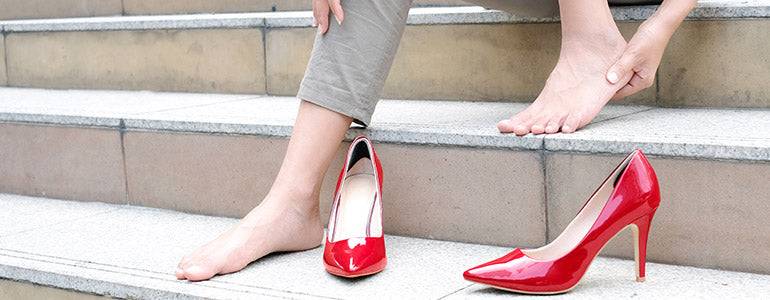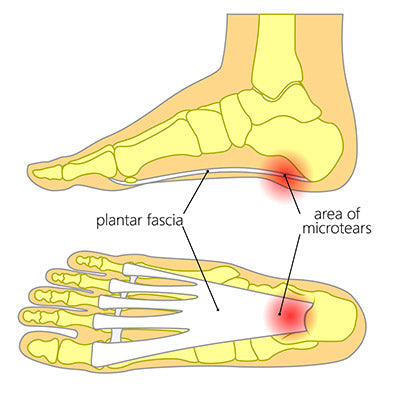The Basics of Plantar Fasciitis

Plantar Fasciitis – Understanding the Basics
Let’s start with what a fascia is. Well, our foot will have a dense, fibrous group of tissues that run from the heels to the toes. This is called a fascia. Generally, this group of tissues will offer support to the muscles, as well as the arch of our foot. If these tissues are subjected to extreme stretching, some kind of wear and tear can occur in its surface, thereby causing pain and inflammation. This condition is called plantar fasciitis.
What are the causes of plantar fasciitis?

Plantar fasciitis can be caused by more than one thing. Most often, individuals will suffer from this symptom as they age or if they are obese or on their feet for hours together a day. While men can also get this condition, it’s found to be more common among females.
Following are the risk factors of getting plantar fasciitis:
- Using worn-out shoes with finer soles
- Having flat feet
- Having a very high arch
- Wearing high-heeled shoes frequently
- Having tight Achilles tendons
- Having heel cords
- Having an abnormal walk/foot position
What are the symptoms of plantar fasciitis?

The symptoms of having plantar fasciitis will include pain that is felt in the lower part of your foot, especially at the front or central of the heel bones. Generally, the patient would find his/her pain gets worsened in the mornings when they take their first step. Also, the pain would be severe when he/she stands up after sitting for a long duration of time.
How is plantar fasciitis diagnosed?
Your physician can say whether you have plantar fasciitis or not simply by checking for tender regions in your foot. Most frequently, he can also tell what causes the pain just by understanding the location of the pain. Normally, no imaging tests will be required for diagnosis. However, in some rare cases, he may order for an X-ray or MRI to rule out other causes.
How can it be cured?
Generally, plantar fasciitis will go off by itself in a few months. However, the pain can be unbearable for you demanding some measures from you. The best way to deal with the pain is to use a heel stretching brace. The idea behind this brace is that if you keep your foot stretched at around 90 degrees while you sleep, the pain caused by plantar fasciitis will be reduced. The heel stretching brace, which has a bendable metal splint, can help you with this. It will provide you the flexible yet solid support thus helping you with faster recovery.
In addition, you can also try resting and try over-the-counter pain medications to decrease swelling and feel at ease. However, we would advise you to speak with your doctor if the condition doesn’t improve or if you could see any redness or bruise on the heels.
What are the treatment options available for plantar fasciitis?
In this section, let’s dive deep into the treatment options that are available for plantar fasciitis:
Plantar Fasciitis Nighttime Braces:
As described above, you can try using a nighttime brace– soft or rigid for helping you with the fastest recovery. For just around $20 to $25, the night time braces can help keep your feet stretched continuously while you sleep, thus giving you an instant relief from pain.
Medications:
The NSAIDs can help you deal with your pain while at the same time reducing the inflammation caused by plantar fascia. You are advised to consult with a doctor before starting any pain relief drugs. In general, your doctor may prescribe one or more doses per day for several weeks.
Steroid Injections:
If the pain you got is so severe that it is not responding to the NSAIDs, you should think about receiving a steroid injection. It will be injected directly into the most painful region to help ease out your pain for at least a month. But, in general, it can help keep the inflammation down for longer than a month.
Physical Therapy:
If all of the above treatments are not helping you enough, the doctor may recommend you to physical therapy. In this, your physical therapist will prescribe exercise for stretching and strengthening your plantar fascia. In addition, massages, contrast baths, and ultrasonography may also be used for long-term relief.
Shock-Wave Therapy:
During this treatment, a literal shock will be administered to your plantar fascia using sound waves to help stimulate the blood flow in your foot and thereby, helping the tissues to heal.
Tenex Procedure:
This will involve a small cut through which an ultrasound will be targeted to remove the scar tissue.
Surgery:
Surgery is the last resort for plantar fasciitis and will be prescribed if the pain is severe or the injury is stubborn. This procedure will take your plantar fascia off of the heel bone.
